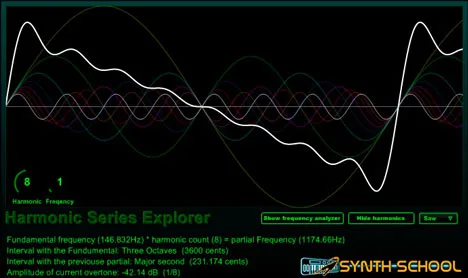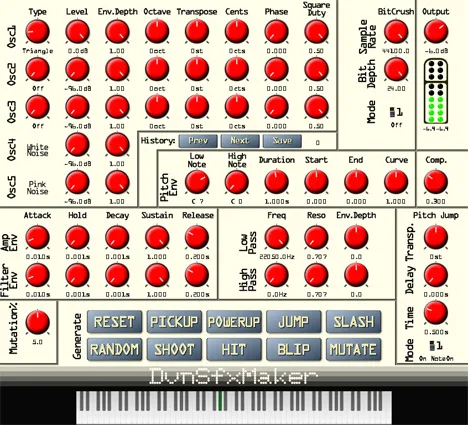Harmonic Explorer: Explore the Fundamentals of Additive Synthesis
Welcome to the world of sound, where each note isn’t just a single tone but a complex mosaic of interacting harmonics, forming a unique timbre. Understanding this multi-layered structure is key for any musician, sound engineer, or sound designer striving to master the art of sound creation and processing. This is where Harmonic Explorer comes into play – a tool developed by Synth School, opening the doors to the fascinating world of additive synthesis.
Additive synthesis is one of the fundamental methods of sound creation, based on the idea that any complex sound can be broken down or assembled from a set of simpler waves, primarily sinusoids. Each sinusoid represents a separate harmonic (or overtone) of the fundamental frequency (the fundamental tone). By adding these harmonics with varying loudness and phase, you can reproduce almost any timbre – from the pure sounds of acoustic instruments to complex extraterrestrial textures.
Why do we need Harmonic Explorer?
In the world of plugins, there are numerous synthesizers that use additive synthesis, but Harmonic Explorer has a special purpose. It is not just a tool for creating music but primarily an educational and research resource. Its main goal is to help the user visually understand how adding and manipulating overtones affects the final sound. This makes it an ideal solution for both beginners who are just getting acquainted with sound synthesis and more experienced users who want to deepen their understanding of acoustic principles.
Key aspects for exploration:
- Fundamentals of Additive Synthesis: The plugin allows you to experiment by adding overtones one by one, observing how the timbre gradually forms. You can start with a simple sinusoid (only the fundamental tone) and gradually “build” the sound, adding the second, third, fourth harmonic, and so on.
- The Role of Overtones: Each overtone has its own frequency, which is a multiple of the fundamental frequency. Their relative loudness and phase are crucial for the unique sound of each instrument or sound. Harmonic Explorer allows you to control these parameters for individual harmonics, demonstrating their direct impact on auditory perception.
- Timbre Formation: Visually see and hear how changing the level of one harmonic can drastically change the character of the sound, making it brighter, darker, richer, or emptier. This understanding is critical for fine-tuning sounds in any synthesizer.
- The Relationship between Spectrum and Timbre: Although the plugin description doesn’t mention a spectral analyzer, the process of adding harmonics visually or conceptually demonstrates what the sound spectrum looks like and how it correlates with what we hear. The plugin teaches you to think about sound not only in terms of notes but also in terms of frequency components.
Using Harmonic Explorer, you can conduct your own sound experiments. For example, explore how the timbre of an open guitar string differs from the timbre of the same string pressed on the fretboard, in terms of harmonic composition (although the plugin doesn’t emulate a guitar, it allows you to understand the principles). Or try to reproduce the approximate timbre of well-known instruments by adding harmonics in the appropriate proportions. It is not an exact emulator, but a powerful educational tool.
Practical Application and Learning
For students of music technology, novice audio engineers, and curious musicians, Harmonic Explorer is an invaluable resource. It transforms abstract concepts of acoustics and synthesis into an interactive experience. Instead of dry theory, you get the opportunity to “touch” the sound and hear with your own ears how the fundamental laws of timbre formation work.
- Helps you understand why different synthesizers sound different, even if they use the same waveforms (for example, sawtooth or square waves – which, by the way, are the sum of certain harmonics).
- Develops auditory skills for sound analysis, allowing you to better identify harmonic content in existing sounds.
- Becomes a solid foundation for further study of more complex synthesis methods, such as subtractive, frequency modulation (FM), etc., as they are all somehow related to manipulations over the harmonic spectrum.
- Stimulates experiments and a creative approach to sound design, because by understanding the basic principles, you can consciously construct desired timbres, not just use presets.
Although Harmonic Explorer is declared as a VST plugin for the Windows operating system (Win32), its value goes beyond being a simple tool for sound creation. It’s a gateway to a deeper understanding of the physics of sound and the art of its synthesis. Synth School offers a simple but effective way for everyone to explore how the richness of timbres that surround us in music and everyday life is born from ordinary sinusoids.
Regardless of your level of experience, take the time to experiment with Harmonic Explorer. Add harmonics, change their volume, listen to how the sound changes. This will not only expand your understanding of sound synthesis but also, perhaps, inspire you to create completely new, unique sound palettes for your music projects. Exploring the harmonic world is the path to mastery in working with sound, and Harmonic Explorer is an excellent guide on this path.



